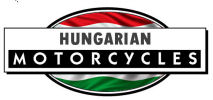




László Urbach, a motorcycle dealer and competitor before the war, introduced the Dongó in 1954. They were remarkably similar to the Garelli Mosquito.
The bicycle auxiliary engine could be fitted to standard bicycle frame and required little mechanical aptitude to do so. They had friction drive to the rear wheel.
Starting was accomplished by pedalling the bicycle, and the pedals were used to aid in climbing hills and in the not infrequent event of engine failure.
The Dongo engine cost roughly two-months wages, plus an additonal three months earnings for the bicycle. They were difficult to obtain and even more diffult to run - distribution was handled by socialist officials with whom one needed to be "friendly", then petrol and oil vouchers must to be obtained from the council, subject again to similar conditions, and it appears that even the roads upon which they were permitted to be ridden were restricted. In 1957 production ceased due to "lack of demand".
Around 60,000 Dongos were built. The last of them were sold in 1960, at half price.
Source: Article at magyarjarmu.hu by Pál Négyesi
If you have a query or information about Hungarian motorcycles please contact us